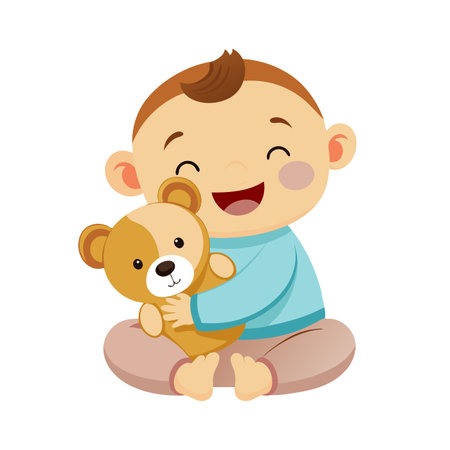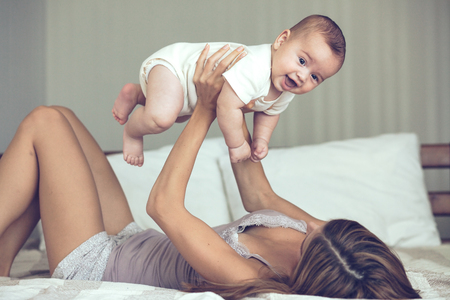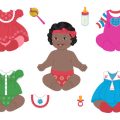1. Understanding Teething and Its Impact on Sleep
Teething is a natural part of your baby’s development, but it can be a tough time for both babies and parents—especially if you’re in the middle of sleep training. Knowing what to expect can help you handle those sleepless nights with more confidence.
What Is Teething?
Teething happens when your baby’s first teeth start to push through their gums. This usually begins around 4 to 7 months old, but every child is different. Some babies get their first tooth earlier or later, so don’t worry if your little one’s timeline looks a bit different from others.
Common Signs of Teething
| Symptom | Description |
|---|---|
| Drooling | Babies may drool more than usual during teething. |
| Irritability | Your baby might seem fussier or crankier than normal. |
| Crying | Increased crying, especially at night or nap time. |
| Chewing on Objects | Babies often want to bite or chew on toys, fingers, or anything they can find. |
| Swollen Gums | You may notice red or swollen gums where the tooth is coming in. |
| Sleep Disruptions | Trouble falling asleep, waking up frequently, or shorter naps. |
Typical Teething Timeline
| Age Range | What Happens? |
|---|---|
| 4-7 months | First teeth (usually lower front) begin to erupt. |
| 8-12 months | Top front teeth come in. |
| 9-16 months | Lateral incisors and more teeth appear. |
| 13-19 months and up | Molars and canine teeth follow; full set by age 3. |
How Teething Disrupts Sleep Patterns During Training
If your baby is teething while you’re working on sleep training, you might notice that bedtime routines become more challenging. The discomfort from sore gums can make it harder for babies to settle down, fall asleep, or stay asleep. Even if you’ve already made progress with sleep training, teething pain can cause temporary setbacks like:
- Frequent night wakings due to discomfort
- Trouble self-soothing back to sleep without help from a parent
- Naps that are shorter than usual or skipped altogether
If your baby suddenly resists sleep training methods they were comfortable with before, teething could be the culprit. Understanding these changes are normal can help you adjust your expectations and approach during this phase.
2. Recognizing Illness During Sleep Training
When you’re sleep training your baby, it’s important to know the difference between normal sleep struggles and signs of illness. Babies can get sick easily, especially with common colds or ear infections, and these illnesses can affect how well sleep training goes. Here’s how to spot the most common illnesses and understand how they might impact your baby’s sleep.
Common Baby Illnesses That Affect Sleep
| Illness | Typical Symptoms | How It Affects Sleep Training |
|---|---|---|
| Cold (Upper Respiratory Infection) | Runny or stuffy nose, mild fever, cough, sneezing | Babies may wake more often due to congestion or discomfort; may need extra comfort |
| Ear Infection | Pulling at ears, irritability, trouble lying flat, fever, poor feeding | Lying down can increase ear pain, causing frequent night wakings and fussiness |
| Fever (Various Causes) | Warm forehead, flushed cheeks, sweating, chills | Sleep may be restless; babies may wake for comfort or hydration |
| Teething (often overlaps with illness) | Drooling, swollen gums, mild temperature increase, chewing on objects | Pain and discomfort can make falling asleep and staying asleep harder |
Tips for Spotting Illness vs. Sleep Regression
- Monitor symptoms: If your baby is waking up more than usual and also shows signs like a runny nose or fever, illness might be the cause.
- Check for patterns: Sudden changes in appetite or mood—like being unusually fussy even during the day—can signal sickness.
- Watch for physical cues: Pulling at ears or rubbing cheeks are classic signs of ear infections or teething.
- Trust your instincts: If your baby seems “off” or much more uncomfortable than usual during sleep training, don’t hesitate to check for illness.
- Consult your pediatrician: Always call your doctor if you’re unsure whether it’s illness or just part of the sleep training process—especially with high fevers or persistent symptoms.
How Illness Can Disrupt Sleep Training Progress
Sick babies usually need extra comfort and care. Illness can temporarily set back sleep training because your baby may wake more often or have trouble settling down. It’s okay to pause strict routines if your little one is unwell—focus on helping them feel better first. Once your child recovers, you can gently return to your chosen sleep training method.

3. Adjusting Your Sleep Training Approach
Every baby is unique, and teething or illness can affect their sleep differently. If your little one is suddenly fussier at bedtime or waking up more often, it may be time to adjust your sleep training approach. Here’s how to know whether you should pause, modify, or continue with your current plan.
When to Pause Sleep Training
If your baby is experiencing a high fever, vomiting, diarrhea, or seems especially uncomfortable, it’s okay to take a break from sleep training. Comfort and care are most important during acute illness. Once they’re feeling better, you can pick up where you left off.
Signs You Should Pause
| Situation | Recommended Action |
|---|---|
| High fever (over 100.4°F/38°C) | Pause sleep training and focus on comfort |
| Vomiting or diarrhea | Pause; keep baby hydrated and comfortable |
| Unusual lethargy or persistent crying | Pause and monitor closely; consult pediatrician if needed |
When to Modify Sleep Training
Mild teething symptoms—like drooling, chewing, or slightly disrupted sleep—might just require small tweaks to your routine instead of a complete pause. Try offering extra cuddles, using a cool teething ring before bed, or extending your bedtime routine by a few minutes for added comfort.
Modification Tips for Teething or Mild Illness
- Offer comfort without creating new sleep associations you don’t want long-term (e.g., try not to start rocking to sleep if you weren’t before).
- Be flexible with your response; if your baby wakes up in pain, offer reassurance and soothing before encouraging them to settle back down.
- Keep the room cool and use a humidifier if congestion is an issue.
When You Can Continue Sleep Training
If your baby only has mild discomfort from teething but is otherwise healthy and alert, you can usually continue with your established sleep training method. Consistency helps babies learn what to expect at bedtime, even when things are a little tough.
Quick Reference Table: Pause, Modify, or Continue?
| Baby’s Condition | Your Approach |
|---|---|
| Mild teething discomfort (drooling, chewing) | Modify routine for extra comfort but keep general structure intact |
| Mild cold (runny nose but no fever) | Slightly modify as needed; offer comfort but stay consistent with routines |
| Fever over 100.4°F/38°C, severe illness symptoms | Pause sleep training; prioritize care and comfort until recovery |
| No significant symptoms despite teething/illness concerns | Continue with regular sleep training methods |
4. Comfort Measures and Remedies
Soothing Your Baby During Teething or Illness at Bedtime
When your baby is teething or feeling under the weather, sleep training can become extra challenging. American parents often look for gentle ways to help their little ones feel better while still encouraging healthy sleep habits. Here are some practical tips and familiar comfort strategies to make bedtime a little easier for both you and your baby.
Safe Pain Relief Methods
| Pain Relief Option | Description | Safety Tips |
|---|---|---|
| Infant Acetaminophen (Tylenol) | Helps reduce fever and relieve pain; commonly used in the U.S. for teething or mild illness. | Always use the correct dosage as directed by your pediatrician; never give adult medicine to babies. |
| Teething Rings (Chilled, Not Frozen) | Cools and soothes sore gums when chewed on before bedtime. | Avoid freezing, as this can harm sensitive gums. Choose BPA-free products. |
| Cold Washcloth | A clean, damp, chilled washcloth for your baby to gnaw on can be very comforting. | Supervise while using to prevent choking hazards. |
| Teething Gels (Over-the-Counter) | Some parents use gels, but consult your doctor first; many brands are not recommended for infants in the U.S. | Avoid gels with benzocaine or lidocaine as these are not safe for babies. |
Comfort Strategies Familiar to American Parents
- Extra Cuddles: Gentle rocking or holding your baby before bed helps them feel secure when they’re uncomfortable.
- White Noise Machines: The soothing sound of white noise can mask discomfort and help lull a fussy baby to sleep—very popular in American nurseries.
- Pacifiers: Many families find pacifiers helpful for soothing a teething or sick baby during sleep training. If your baby is already used to one, offer it at bedtime.
- Consistent Bedtime Routine: Stick with familiar activities like a warm bath, storytime, or soft lullabies even when your baby isn’t feeling well. This signals that it’s time for sleep and provides comfort through routine.
- Slightly Elevated Sleep Position: If your baby has a stuffy nose, gently elevating the crib mattress (never use pillows directly) can help them breathe easier. Always follow safe sleep guidelines from the American Academy of Pediatrics (AAP).
- Room Temperature: Keep the room comfortably cool—around 68–72°F (20–22°C)—to help soothe fevers and ensure restful sleep.
If You’re Unsure About Remedies…
If you ever have questions about using medications or any home remedies, check with your pediatrician first. Keeping open communication with your child’s doctor is always the safest approach when handling teething pain or illness during sleep training.
5. When to Get Professional Help
Recognizing When to Call Your Pediatrician
Sleep training while your baby is teething or feeling under the weather can be extra challenging. Sometimes, it’s tough to know when your little one just needs comfort and when you should call your pediatrician. Here are some signs that it’s time to reach out for professional help:
| Sign | What It Might Mean |
|---|---|
| High fever (over 100.4°F or 38°C) | Could indicate an infection needing medical attention |
| Persistent vomiting or diarrhea | Risk of dehydration; needs evaluation by a doctor |
| Trouble breathing or wheezing | Possible respiratory issue; seek help right away |
| Refusal to eat or drink for more than 8 hours | Could lead to dehydration or weight loss |
| Unusual lethargy or irritability | Might be more than teething or minor illness |
| No improvement after several days of home care | Might need further investigation by a pediatrician |
Balancing Expert Advice with Sleep Training Goals
If your child is sick or teething, sleep routines will likely be disrupted. Your pediatrician can help guide you on what’s best for your child’s health and development. Here are some tips for balancing their advice with your sleep training plan:
- Communicate openly: Let your pediatrician know about your current sleep training methods and any concerns.
- Follow medical advice first: Health always comes before sleep milestones. If your doctor recommends pausing sleep training, follow their lead.
- Ask specific questions: For example, “Is it okay to continue gentle sleep training if my baby has a mild cold?”
- Create a flexible routine: Be prepared to adjust naps and bedtime if your child is uncomfortable or unwell.
- Use comfort measures as needed: Extra cuddles, soothing, and hydration may be necessary until your child feels better.
Quick Reference: When in Doubt, Reach Out!
If you’re ever unsure whether symptoms are normal or something more serious, don’t hesitate to call your pediatrician. Trust your instincts—you know your child best!


